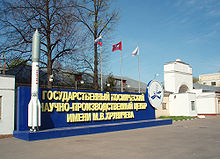GKNPZ Khrunichev

Khrunichev State Research and Production Space Center ( Russian ГКНПЦ им М. В. Хруничева. / Gossudarstwenni Kosmitscheski Nauchno-Proiswodstwenni Central Imeni MW Chrunitschewa -. Cosmic on dt State Research and Production Center "MW Khrunichev" English Khrunichev ) is a Russian manufacturer of rockets and spacecraft. The company was named after the Soviet Minister of Aviation Industry Mikhail Khrunichev (1901–1961).
history
The company goes back to a foundation initiated by Russo-Balt in 1916 as the second automobile company "Russo-Balt" ("Второй автомобильный завод" Руссо-Балт ""). Around 1500 to 2000 automobiles were to be produced there annually, but production in the plant, which was partly equipped with factory machines of American design, never got going because of the October Revolution and the subsequent civil war. The first five "Russo-Balt" automobiles were not produced until 1922.
From 1923 the plant was leased to the Junkers works as part of the German-Soviet cooperation set out in the Rapallo contract as a branch "Junkers-Werke Dessau, Headquarters for Russia". By 1925 around 50 Junkers Ju 20 , 100 Ju 21 and some Ju 13 aircraft had been produced.
Domestic all-metal types were also produced later, first the Tupolew R-3 , from 1926 the Tupolew TB-1 . In 1927 the agreement with Junkers was terminated and in March it was incorporated into the Soviet "Awiatrust" with the number 22. After repairs, the production of further Tupolev aircraft ( TB-3 , R-6 , from the 1930s SB- 2 and Petlyakov Pe-2 ). Due to the German advance , Plant No. 22 was relocated to Kazan in December 1941 and rebuilt there as Plant No. 124, where production of the Pe-2 and the four-engine Pe-8 bomber resumed. Plant No. 23 was built on the old site, which in the further course of the war produced the Ilyushin Il-4 and Tupolev Tu-2 bombers.
After the end of the war , the Tupolev Tu-12 and the Tupolev Tu-4 that emerged from the Boeing B-29 followed , from 1951 the Myasishchev M-4 and the supersonic bomber Myasishchev M-50 , after 1960 the world's largest helicopter, the Mil Mi-6 . The company was named MW Khrunichev in 1961 when the minister died.
The rocket age began with the ballistic ICBM UR-200 (SS-10 Scrag), a new development based on the R-14 , which was abandoned in 1962 in favor of the UR-100 . At the same time, the development of the Proton rocket began . Other products from military and civil space travel followed.
On June 7, 1993, by a decree by Boris Yeltsin, the company was merged with the KB Salyut design office , part of the NPP Energija , to form the GKNPZ Khrunichev.
Holdings
Together with EADS , Khrunichev operates Eurockot Launch Services GmbH for the launch of the Rockot missiles. In addition, the launches of Proton rockets are marketed internationally together with RKK Energija as part of International Launch Services . Before 2006, Lockheed Martin was also one of the owners of ILS, so that the Atlas V was also marketed by ILS alongside the Proton. Since May 2008 GKNPZ Khrunichev has been the main shareholder of ILS.
Current projects
- proton
- Angara
- Rockot
- Bris high school
- KWRB upper level
- Multipurpose Laboratory Module
- Monitor satellites
- KazSat
- Express MD
literature
- Dimitri Alexejewitsch Sobolew: German traces in Soviet aviation history. Mittler Verlag, 2000, ISBN 3-8132-0675-0 .
- Andrej O. Aleksandrov, Gennadij F. Petrov: The German aircraft in Russian and Soviet services. Volume 1: 1914-1951. Flugzeug Publikations GmbH, 1997, ISBN 3-927132-43-8 .
Individual evidence
- ^ The Soviet aircraft factories 1941–1945. ( Memento from August 4, 2012 in the web archive archive.today )
- ↑ History of the factory (Russian)
- ↑ ilslaunch.com
- ↑ ilslaunch.com
Web links
- Official website (English and Russian)